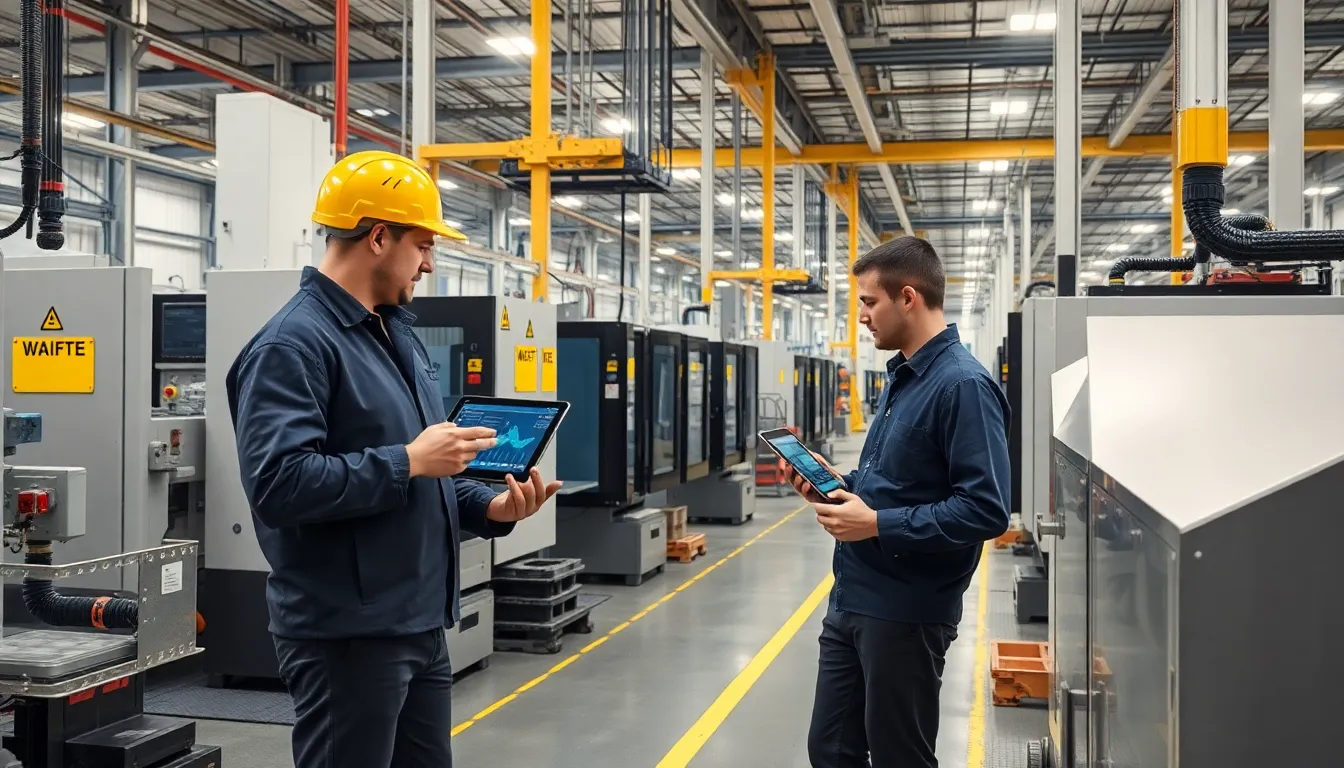Table of Contents
ToggleIn today’s fast-paced digital landscape, IoT integration stands at the forefront of technological innovation. As more devices connect to the internet, the seamless interaction between them transforms industries and enhances everyday life. From smart homes to industrial automation, integrating IoT solutions is no longer a luxury—it’s a necessity for businesses aiming to stay competitive.
The potential of IoT integration lies in its ability to streamline processes and improve efficiency. By harnessing real-time data, organizations can make informed decisions that drive growth and innovation. As this technology evolves, understanding its implications and best practices becomes crucial for anyone looking to leverage its full potential.
Overview of IoT Integration
IoT integration involves connecting physical devices to the internet and enabling them to communicate and share data. This process serves multiple industries, such as healthcare, manufacturing, and transportation, significantly enhancing operational efficiency.
IoT systems consist of three primary components: sensors, communication networks, and cloud-based platforms. Sensors collect data from the environment, while communication networks transmit this data to cloud platforms for processing and analysis.
The benefits of IoT integration are substantial. Improved decision-making occurs through real-time data analysis, enabling businesses to respond quickly to changes. Enhanced automation streamlines operations, reducing the need for manual intervention. Increased efficiencies lead to cost savings; for instance, predictive maintenance can decrease downtime and repair costs by up to 30%.
Best practices for successful IoT integration include:
- Strategic planning: Identify specific goals and target outcomes.
- Security measures: Implement robust security protocols to protect sensitive data.
- Scalable architecture: Design systems that can grow with business demands.
- Interoperability: Ensure compatibility among various devices and platforms.
- Continuous monitoring: Regularly assess performance and make necessary adjustments.
Understanding these aspects of IoT integration enables businesses to harness its full potential, driving innovation and improving customer experiences across various sectors.
Benefits of IoT Integration

IoT integration offers significant advantages that enhance both operations and financial performance across industries. Businesses that leverage IoT systems can access real-time insights, improving their adaptability and competitiveness.
Enhanced Efficiency
Enhanced efficiency through IoT integration leads to streamlined operations. Data from sensors enables automation, optimizing processes in real-time. For instance, smart manufacturing systems monitor machinery conditions, predicting maintenance needs before failures occur. Consequently, this proactive approach reduces downtime, allowing for continuous production. Additionally, connected devices can adjust operations automatically, ensuring optimal performance without manual intervention. Improved data availability informs better resource allocation, reducing waste significantly.
Cost Reduction
Cost reduction represents a major benefit of IoT integration. By utilizing real-time data, organizations can identify inefficiencies and implement corrective measures swiftly. For example, predictive analytics in supply chain management minimizes excess inventory and lowers storage costs. Energy management systems optimize energy usage, leading to decreased utility bills. Furthermore, IoT devices enable remote monitoring, reducing the need for on-site human intervention and cutting labor expenses. Effective data analysis aids in cost forecasting, empowering businesses to make financially sound decisions efficiently.
By embracing IoT integration, companies gain a competitive edge, enhancing efficiency and achieving substantial cost savings.
Challenges in IoT Integration
IoT integration faces several challenges that can hinder its effectiveness. Addressing these obstacles is crucial for maximizing the benefits of IoT technologies.
Security Concerns
Security concerns pose significant risks in IoT integration. Millions of connected devices increase the potential attack surface for cyber threats. Vulnerabilities in devices, networks, and cloud platforms can lead to unauthorized access, data breaches, and loss of sensitive information. For instance, in 2020, the average cost of a data breach reached $3.86 million, as reported by IBM. Implementing strong security protocols, including encryption, regular software updates, and robust authentication mechanisms, mitigates potential attacks. Organizations must also conduct thorough risk assessments to identify and address vulnerabilities proactively.
Interoperability Issues
Interoperability issues create barriers in IoT integration. Different devices, platforms, and protocols often lack seamless communication, resulting in inefficiencies. Without standardized protocols, data sharing can become inconsistent and reduce the effectiveness of IoT solutions. According to Gartner, by 2024, 75% of IoT initiatives will lack adequate interoperability, causing delays in projects. Organizations can overcome these challenges by adopting open standards and investing in middleware solutions that promote compatibility among various systems. Ensuring interoperability enhances data flow and supports comprehensive analytics across devices, ultimately driving better decision-making.
Successful Case Studies
Successful implementation of IoT integration spans various industries, demonstrating its transformative potential. Below are key examples highlighting significant applications and innovations within this technology.
Industry Applications
- Healthcare: IoT integration allows for real-time patient monitoring through wearable medical devices. These devices collect data on heart rates and oxygen levels, enabling healthcare providers to track patient health remotely, reduce hospital visits, and respond swiftly to emergencies.
- Manufacturing: Smart factories utilize IoT solutions for predictive maintenance. Sensors attached to machinery collect data on performance metrics, predicting failures before they occur. This practice minimizes downtime and enhances productivity by ensuring machines operate at optimal levels.
- Transportation: IoT enhances fleet management through GPS tracking and telematics systems. Companies can monitor vehicle conditions and driver behavior, optimizing routing, reducing fuel consumption, and ensuring timely deliveries, which leads to higher operational efficiency.
- Agriculture: Smart farming employs IoT for precision agriculture. Sensors monitor soil moisture levels and weather conditions, providing farmers crucial insights. This data-driven approach optimizes water usage and boosts crop yields, promoting sustainable practices.
Innovations in IoT Integration
- Edge Computing: Edge computing processes data closer to the source rather than relying on centralized cloud servers. This innovation improves response times and bandwidth efficiency for IoT applications, allowing for real-time analytics and decision-making.
- Artificial Intelligence (AI) and Machine Learning (ML): Integrating AI and ML into IoT systems enhances data analysis capabilities. These technologies can identify patterns and predict outcomes, improving automation and operational efficiency across sectors.
- Blockchain: Blockchain technology enhances security and transparency in IoT integrations. By providing a decentralized ledger for device interactions, it protects against data tampering and assures users of reliable data sharing.
- 5G Technology: The advent of 5G dramatically increases bandwidth and reduces latency. This enables more devices to connect seamlessly, facilitating massive IoT networks that support real-time data sharing and complex applications.
Future Trends in IoT Integration
Future trends in IoT integration focus on advancing technologies and increasing connectivity across industries. Organizations prioritize enhanced security measures, given the rising concerns about data breaches. Utilizing end-to-end encryption and adopting frameworks like Zero Trust can help mitigate risks associated with connected devices.
Emerging technologies such as edge computing gain traction, allowing data processing closer to the source. This approach reduces latency and improves real-time analytics, which is essential for time-sensitive applications. For instance, smart cities utilize edge computing to manage traffic signals and optimize public transportation more efficiently.
Artificial intelligence and machine learning integration into IoT systems transforms data analysis capabilities. These technologies enhance predictive analytics, which allows organizations to make proactive decisions based on data trends. In agriculture, this integration leads to better crop management, increasing yield while optimizing resource use.
5G technology’s roll-out enhances IoT integration further by providing higher bandwidth and lower latency connections. This improvement enables more devices to connect seamlessly, promoting the development of smart homes and industrial IoT applications. For example, smart appliances can communicate and operate collectively, improving energy efficiency.
Sustainability remains a significant trend in IoT integration, with a focus on reducing energy consumption and waste. Reports indicate that IoT solutions improve energy management systems by optimizing utility usage in real-time. For instance, smart grids leverage IoT data to balance energy distribution more effectively, minimizing losses.
Collaboration across industries also becomes vital for IoT integration. Businesses forge partnerships to share data, enhance interoperability, and create comprehensive solutions. Health care and technology companies collaborate on wearable devices that not only monitor health metrics but also feed data into broader health systems for improved patient care.
Overall, the future of IoT integration encompasses enhanced security, improved data processing, advanced analytics, and a continued emphasis on sustainability, shaping the way organizations operate and interact with technology.
IoT integration is reshaping industries and enhancing everyday life in profound ways. By connecting devices and enabling seamless data exchange, organizations can unlock new levels of efficiency and innovation. The focus on security and interoperability ensures that businesses can navigate challenges while maximizing the benefits of this technology.
As IoT continues to evolve with advancements like edge computing and 5G, the potential for improved decision-making and resource management grows. Embracing these changes allows companies to stay competitive and responsive to market demands. The future of IoT integration promises not only operational improvements but also a commitment to sustainability and collaboration across sectors.







